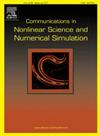Graph limit and exponential consensus for the large-scale multi-agent system with delay
IF 3.4
2区 数学
Q1 MATHEMATICS, APPLIED
Communications in Nonlinear Science and Numerical Simulation
Pub Date : 2025-05-13
DOI:10.1016/j.cnsns.2025.108919
引用次数: 0
Abstract
This is a classical problem in mathematical physics to describe the dynamics of large-scale multi-agent systems. In this paper, we propose a limit graphon integral-differential system with a weight feature of graphon to represent a large-scale second-order delay multi-agent system, where the time delay represents transmission time lags. We first study the well-posedness, stability, and regularity of the limit system. When the number of agents tends to infinity, we prove that the delay multi-agent system strongly converges to the delay graphon limit system. Then, by utilizing the novel perturbed energy function and delayed matrix exponential estimate methods, we give sufficient conditions for the exponential convergence consensus of the delay graphon limit system. Numerical simulation examples are given to illustrate our results.
大规模时滞多智能体系统的图极限与指数一致性
描述大规模多智能体系统的动力学是数学物理中的一个经典问题。本文提出了一种以石墨烯为权重特征的极限石墨烯积分-微分系统来表示大规模二阶延迟多智能体系统,其中时间延迟表示传输时滞。首先研究了极限系统的适定性、稳定性和正则性。当智能体数量趋于无穷时,证明了延迟多智能体系统强收敛于延迟石墨极限系统。然后,利用新的摄动能量函数和延迟矩阵指数估计方法,给出了延迟石墨极限系统指数收敛一致性的充分条件。最后给出了数值模拟实例来说明本文的研究结果。
本文章由计算机程序翻译,如有差异,请以英文原文为准。
求助全文
约1分钟内获得全文
求助全文
来源期刊

Communications in Nonlinear Science and Numerical Simulation
MATHEMATICS, APPLIED-MATHEMATICS, INTERDISCIPLINARY APPLICATIONS
CiteScore
6.80
自引率
7.70%
发文量
378
审稿时长
78 days
期刊介绍:
The journal publishes original research findings on experimental observation, mathematical modeling, theoretical analysis and numerical simulation, for more accurate description, better prediction or novel application, of nonlinear phenomena in science and engineering. It offers a venue for researchers to make rapid exchange of ideas and techniques in nonlinear science and complexity.
The submission of manuscripts with cross-disciplinary approaches in nonlinear science and complexity is particularly encouraged.
Topics of interest:
Nonlinear differential or delay equations, Lie group analysis and asymptotic methods, Discontinuous systems, Fractals, Fractional calculus and dynamics, Nonlinear effects in quantum mechanics, Nonlinear stochastic processes, Experimental nonlinear science, Time-series and signal analysis, Computational methods and simulations in nonlinear science and engineering, Control of dynamical systems, Synchronization, Lyapunov analysis, High-dimensional chaos and turbulence, Chaos in Hamiltonian systems, Integrable systems and solitons, Collective behavior in many-body systems, Biological physics and networks, Nonlinear mechanical systems, Complex systems and complexity.
No length limitation for contributions is set, but only concisely written manuscripts are published. Brief papers are published on the basis of Rapid Communications. Discussions of previously published papers are welcome.
 求助内容:
求助内容: 应助结果提醒方式:
应助结果提醒方式:


